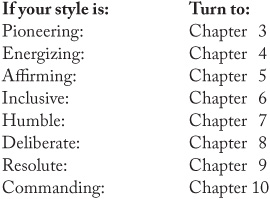Part 2
A Deeper Dive Into Your
Primary Dimension
In Part 1, we provided some background information on DiSC®, described the 8 Dimensions of Leadership, and explained the value of this multidimensional model. Once you gained some baseline knowledge, you had the chance to take the online assessment or place yourself on the model using the information in Chapter 2. Now that you know your primary leadership dimension, it’s time to explore one simple but important question: “So what?”
As we’ve discussed, most leaders use different dimensions as situations call for them, but we all have one default dimension that feels most comfortable. Rest assured that within each style of leadership there is still plenty of room for individuality. However, there are also distinct patterns that we see among leaders with a particular style. By understanding the behaviors that are associated with your primary leadership dimension, you can get a head start on the difficult task of identifying your leadership blind spots—those tendencies that can hold you back from more effective leadership.
In Part 2, we’re going to talk about specific psychological drivers that affect how you approach leadership. More specifically, we’re going to talk about how these drivers—many of which make you successful in certain areas—can limit your ability to lead effectively. Now, we realize that this isn’t generally how people make friends: “Nice to meet you. Let me tell you what you’re doing wrong.” Before you can really work on improving your effectiveness as a leader, you need to be fully aware of the natural tendencies that you bring to leadership. These tendencies are not only your strengths, but when overused, they can cause you to fall short in other areas. In other words, when you focus too much on your primary leadership dimension, you can unknowingly overlook other dimensions that may be vital in your current situation.
Part of the beauty of the 8 Dimensions of Leadership Model is that it is often able to predict the issues that will pop up for leaders with a particular style. Affirming leaders, for example, tend to have a common set of challenges, some of which stem from a need to feel accepted. Resolute leaders, on the other hand, have another set, some of which are related to a need for personal mastery. The insights that we present in this section are built not only on decades of DiSC research, but also on a wealth of knowledge from the broader field of psychology. Our goal was to take that information and put it into a form that’s accessible to real-world leaders.
Not every issue that we bring up in your chapter is going to resonate with you. Some of the psychological drivers that we discuss may be problems that you dealt with a long time ago. Other areas may never have been a problem for you personally. Our hope, however, is to get the wheels turning—to help you dig deeper into some of the hidden assumptions and needs that drive you to lead the way you do. So, we encourage you to turn to the chapter about your primary leadership dimension. Your job is simply to read your chapter and honestly ask yourself, “Do I do that?”

